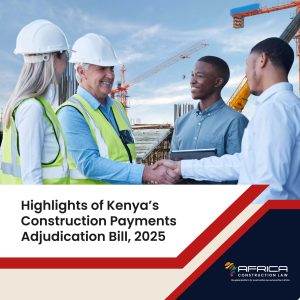THE LEGAL POSITION ON LIABILITY FOR CONCURRENT DELAY IN SOUTH AFRICAN CONSTRUCTION LAW
By Michelle Porter-Wright, Robert Thackwell, and Wihan Meintjes of Allen & Overy LLP (South Africa)
Concurrent delay occurs when two or more distinct events delay a construction project’s completion at the same time. While true concurrency is rare in practice, it gives rise to a complex issue for South African lawyers: who is liable for delay and costs? This question has implications for the entitlement to extensions of time, penalties, or compensation.
This article examines the legal position on concurrent delay and cost allocation in South Africa. It contrasts South African principles with the Society of Construction Law (SCL) Delay and Disruption Protocol, a persuasive but non-binding authority in the UK and other jurisdictions.
The internationally accepted approaches
In the absence of contractual provisions that allocate the risk of concurrent delay, two main approaches are recognized internationally for determining liability:
- The dominant cause approach, which attributes the loss, damage, or delays to the party who caused the predominant or overriding factor of the delay, irrespective of the other party’s or other factor’s influence. This approach may appeal to the party who is less culpable, or who has a clear or strong contractual right to damages, penalties, or extensions of time.
However, this approach may also be challenged for being arbitrary, simplistic, or inequitable, as it may overlook or disregard the complexity, interdependence, or proportionality of the delay factors, or the contractual duties or rights of the parties.
- The apportionment approach, which distributes the loss, damage, or delays among the parties according to their respective levels of fault, contribution, or responsibility for the delay, or according to their respective contractual liabilities or entitlements. This approach may appeal to the party who is more or equally culpable, or a party who has a weak or uncertain contractual basis for damages, penalties, or extensions of time.
However, this approach may also be challenged for being subjective, difficult, or impractical, as it may require a detailed, factual, and legal examination of the delay factors, or a complex quantification of the loss or damage.
The South African approach to concurrency in the context of contractual breach
In construction contracts, the South African judiciary has not adopted a consistent approach to the allocation of liability for concurrent delay and the industry faces divergent views and decisions on this matter.
Nonetheless, some general principles emerge from the South African law of contract and delict, especially the law on causation and loss:
- The causation inquiry in South African law involves two stages. Firstly, establishing the factual cause, which depends on fact and evidence; and secondly, establishing the legal cause, which depends on policy and fairness. The factual cause is determined by applying the “but for” test, which queries whether the loss or damage would have occurred in the absence of the breach. The legal cause is determined by applying the “remoteness” test, which queries whether the loss or damage was reasonably foreseeable or not too remote.
- The legal position on concurrency for contractual claims was elucidated by the Supreme Court of Appeal (SCA) in Thoroughbred Breeders’ Association of South Africa v Price Waterhouse 2001 4 All SA 116 (A) (Thoroughbred Breeders Case). The SCA held that the general rule is that the defaulting party is liable for all loss or damage caused by its breach or delay, irrespective of other causes. The SCA dismissed the notion that the defaulting party is only liable for a proportion of the loss or damage arising from its breach or delay. In particular, the SCA held that the Apportionment of Damages Act – a dated statute that permits apportionment of liability for damages – “does not fit a contractual claim” and only applies to delictual (i.e. tort based) claims.[1]
- Hence, for a claimant to recover damages for breach of contract in the presence of other causative factors, the breach must be a sine qua non and a legal cause of the loss. The breach must have been a factual and legal contributor to the loss, which would not have ensued in its absence. However, the breach need not be the preponderant or exclusive cause of loss for the claimant to recover, as long as it is a substantial cause.
A sui generis South African approach to concurrent delay?
The authors submit that, in cases of concurrent delay as a subset of the concurrent breach, the South African courts will be inclined to favor the contractor in line with the prevailing approach and grant an extension of time and additional payment for a delay event attributable to an employer risk, even if the contractor is liable for another delay event concurrently. In other words, and at South African common law, the contractor is likely to be entitled to claim extra time and cost if it has a contractual right to do so, irrespective of its own substantial breaches and concurrent delays.
It seems therefore that the South African courts will adopt their own distinctive approach to concurrent delay, which diverges from the conventional tests of dominant cause or apportionment applied in other jurisdictions.
This approach has some merit. It is more straightforward and certain than the conventional tests of dominant cause or apportionment because it obviates the need for a factually intensive inquiry into the primary cause in what are inevitably complex and interrelated causes of delay. The approach also follows established South African doctrines of breach, causation, and loss.
However, this approach may be criticized as unfair or disproportionate, as it ignores the reality that contracting parties often face delays from both sides. It allows the contractor to recover fully for a delay that has been partly caused. This approach may also encourage a contractor to delay or prolong the works if it can benefit from an employer’s concurrent delay, and/or otherwise disrupt the contractual allocation of risk and responsibility for the delay.
The authors’ view is that the South African approach to contractual concurrency, and by implication concurrent delay, is obsolete and impracticable, particularly in a construction setting where projects involve rising levels of complexity. It is preferable that the legislature and/or judiciary tackle the question of liability in instances of contractual concurrency explicitly, and devise a feasible and internationally harmonious approach, including the question of concurrent delay.
Comparison with the SCL Protocol
The SCL Protocol expressly deals with the question of concurrent delay. It sets out a definition and a suggested method for allocating responsibility. It proposes that, in the absence of contractual provisions to the contrary, the contractor should receive an extension of time for the period of concurrent delay, but not compensation (save in circumstances where the contractor can separate the additional costs caused by the employer delay from those caused by the contractor delay).
However, the SCL Protocol differs from the South African position in several respects:
- The SCL Protocol provides a clear definition of concurrent delay, whereas the South African courts have not formulated one.
- The SCL Protocol applies a proportional approach to concurrent delay, whereas the South African approach is based on a more favorable and entitlement-oriented view of concurrent delay.
- The SCL Protocol grants the contractor time but not costs, whereas the South African approach allows both.
Conclusion
In conclusion, the legal position on the allocation of liability and costs for the concurrent delay in South Africa is uncertain. The apex courts have not dealt definitively on this point. However, barring legislative intervention or judicial activism, the courts are likely to apply the general rules of causation and contract law to cases involving concurrent delay. This entails that a contractor can secure additional time and cost for a delay event which is an employer risk, even if it contributed significantly to the delay.
The SCL Protocol proposes an alternative approach to concurrent delay, which may offer advantages to the construction sector in South Africa and represent a more equitable allocation of risk. But this protocol lacks legal authority and its applicability to a South African setting may depend on the contractual terms and the facts of each dispute.
Therefore, contractors must scrutinize the facts and the contract for each delay claim, and demonstrate clearly the causation and the consequences of the delay events. Further, to protect and enforce their contractual rights and duties around concurrent delay and its costs, contractors and employers must adhere to the contractual requirements for giving notice and making claims, keep accurate and verifiable records of the delays and their sources, and support their claims with full details and evidence.
[1] Thoroughbred Breeders Case, para 74.


















